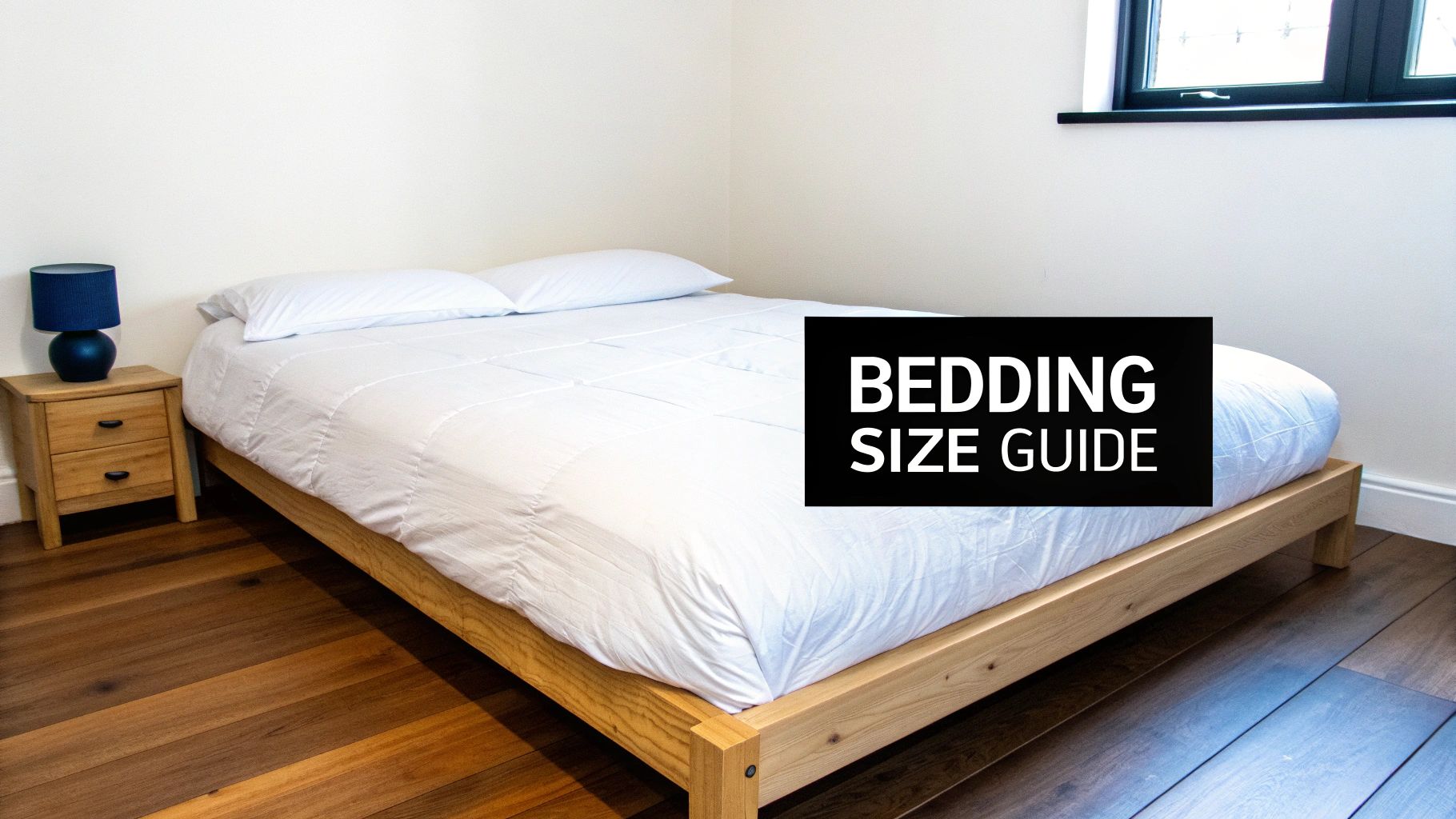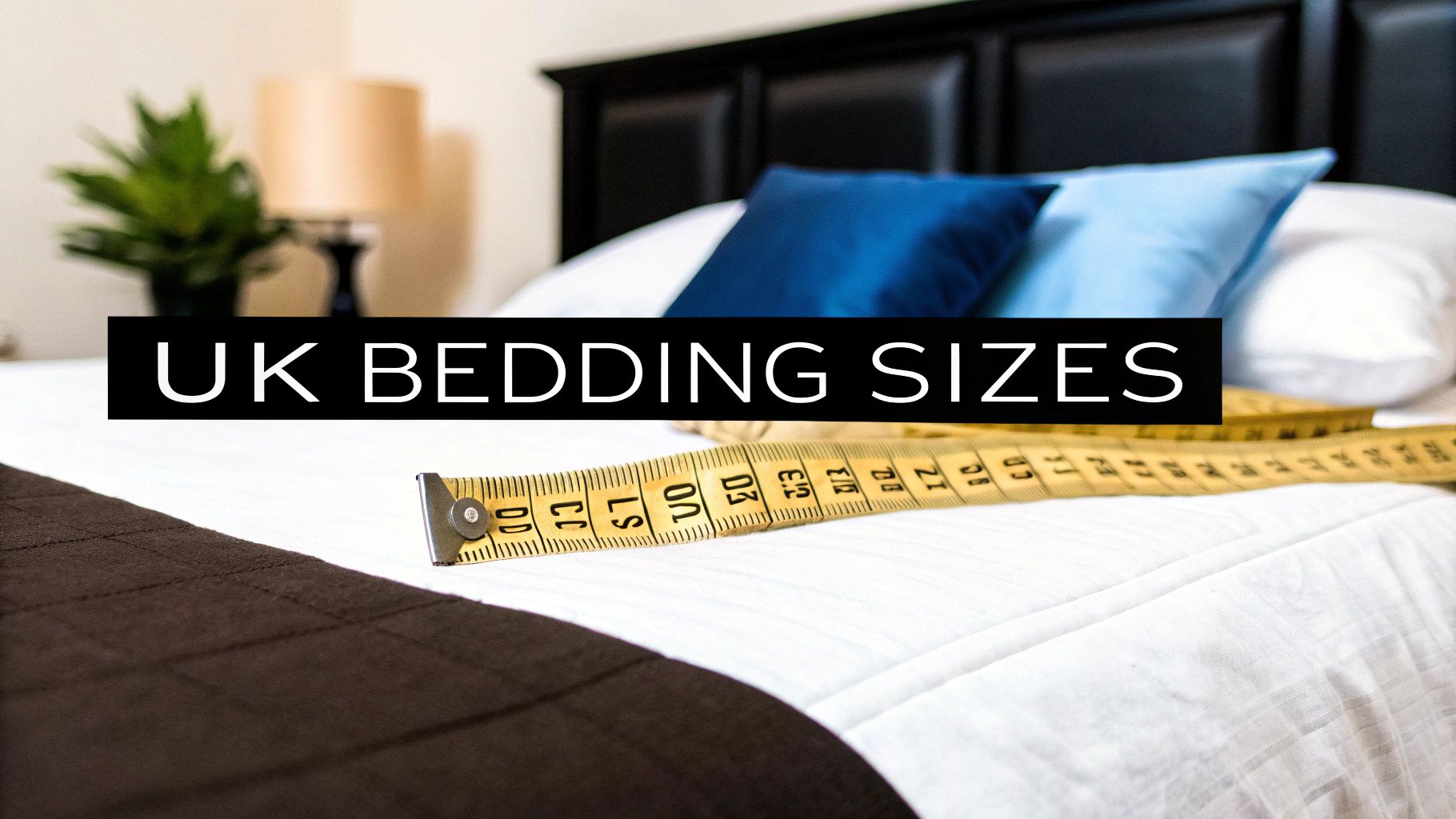Getting your bedding size right can feel a bit baffling, but it’s the secret to creating a bed that is both comfortable and stylish. The first thing to realise is that UK bedding size dimensions often don't match up with mattress names in the way you might expect. For instance, many people assume a King size duvet is the perfect fit for a King size mattress, but this common mistake often leads to a nightly tug-of-war for the covers.
A Quick Reference Guide to UK Bedding Sizes

Choosing the right bedding is about much more than just matching labels. It’s about getting the perfect amount of drape, warmth, and comfort for a genuinely restful night’s sleep. The golden rule is simple: your duvet should always be wider and longer than your mattress.
Here in the UK, our standard bed sizes have been shaped by history and the practicalities of British homes, which means they are often more compact than their US counterparts. The most common sizes you'll come across are the Single (91 x 190 cm), Double (137 x 190 cm), and King (152 x 198 cm). These dimensions are a nod to our typically smaller bedrooms.
Here are a few reasons why getting the size right matters:
- Generous Coverage: A larger duvet is your best defence against chilly draughts, making sure both you and your partner stay comfortably covered all night long.
- A Beautiful Look: A well sized duvet drapes beautifully over the sides of the bed. This creates that polished, hotel style finish that looks so inviting.
- Ultimate Comfort: At the end of the day, having enough duvet to snuggle into without pulling it from someone else simply makes for a better, more peaceful sleep.
Understanding the relationship between your mattress and duvet is key. To make things clearer, you can explore what duvets and covers are in our detailed guide. A little knowledge here will give you the confidence to choose the perfect bedding every time.
How to Measure Your Bed and Bedding Correctly
Getting your bedding dimensions spot on is the secret to a perfectly dressed bed. Before you even think about buying, it's worth grabbing a tape measure. Having accurate numbers is the best way to avoid the classic frustration of a fitted sheet pinging off the corners in the middle of the night.
Let's start with the foundation, your mattress. You only need three simple measurements.
- Width: Measure from the left side to the right side, right across the mattress's widest point.
- Length: Run your tape measure from the head of the mattress straight down to the foot.
- Depth: This one is crucial. Measure from the bottom edge of the mattress to the very top seam. It's important not to press down, especially if you have a plush pillow top.
The mattress depth is the dimension people most often forget, yet it’s what determines whether your fitted sheet will actually stay put. As a rule of thumb, if your mattress is deeper than 30 cm, you will likely need to look for 'deep fitted' or 'extra deep' sheets to get that snug, secure fit.
When it comes to duvets, the easiest method is to lay your current one completely flat on the floor and measure its width and length. This gives you a solid baseline for your next purchase. For more specific guidance on other bedding types, you can learn what size a king quilt is in our related article.
A Detailed Chart of UK Mattress Dimensions
Trying to get your head around bedding size dimensions can sometimes feel like you're learning a new language. With names like 'Small Double' and 'Emperor' floating around, it's easy to get confused. But knowing the exact measurements of your mattress is the crucial first step to creating a bed that not only looks fantastic but also perfectly suits your room and how you sleep.
To get that perfect fit, you will need to measure your mattress's width, length, and depth. This handy infographic quickly shows you the three essential measurements you need to take.

As you can see, the width and length define the bed's footprint in your room, but it's the mattress depth that really matters when it comes to getting your fitted sheets just right.
UK Standard Mattress Size Dimensions
To make things easier, here is a quick reference table with all the standard UK mattress sizes. This should help you pinpoint exactly what you need, whether you're dressing a new bed or just updating your linens.
| Mattress Size Name | Dimensions (cm) | Dimensions (inches) | Best Suited For |
|---|---|---|---|
| Cot | 60 x 120 cm | 23.6" x 47.2" | Infants and toddlers, fits standard cots. |
| Small Single | 75 x 190 cm | 29.5" x 75" | Toddler beds, small guest rooms, or bunk beds. |
| Single | 90 x 190 cm | 35.4" x 75" | Children, teenagers, and single adults. |
| Small Double | 120 x 190 cm | 47.2" x 75" | Single sleepers wanting extra space, or cosy couples. |
| Double | 135 x 190 cm | 53.1" x 75" | The most common size for couples. |
| King | 150 x 200 cm | 59.1" x 78.7" | Couples who appreciate more personal space. |
| Super King | 180 x 200 cm | 70.9" x 78.7" | The ultimate choice for luxurious, spacious comfort. |
| Emperor | 200 x 200 cm | 78.7" x 78.7" | Grand bedrooms where maximum space is a priority. |
This chart covers the most common sizes you'll find here in the UK. Remember that these are standard measurements, so it's always a good idea to double check your own bed frame before making a purchase.
Finding Your Perfect Mattress Size
From a compact single that’s ideal for a child's room to a luxurious Super King offering an abundance of space, there really is a standard size for every situation. A 'Small Double', for instance, is a brilliant solution for guest rooms or smaller main bedrooms. It gives you a bit more room than a single without taking over the entire space.
On the other hand, a Super King is all about indulgence and supreme comfort. If you want to dive deeper into this popular large size, have a look at our guide on what size is a superking.
For those with larger bedrooms and specific sleep needs, it's also worth looking into different setups. Comparing King vs. Split King mattress options is a great way to understand how different configurations work, especially if you're considering an adjustable base.
Ultimately, your bed should be your sanctuary. Simply choosing a mattress size that lets you stretch out freely is one of the easiest yet most effective ways to improve your sleep quality.
Understanding UK Duvet and Sheet Sizes
Choosing the right duvet is about more than just finding the perfect tog rating, it’s about getting the coverage just right. A common mistake people make is buying a 'Double' duvet for a 'Double' mattress, which sounds logical but often leads to that nightly tug of war for the covers.
The best kept secret for a truly comfortable bed is to always go one size larger with your duvet. This guarantees a generous drape over the sides of the mattress, which not only looks more inviting but also stops any unwelcome draughts. If you have a double bed, for example, a king size duvet will give you that luxurious, hotel style feel and make sure everyone stays cosy.
Getting the Right Fit for Your Sheets
When it comes to sheets, however, the sizing advice is quite different. For a bed to look neat and feel right, your sheets need to match your mattress size precisely. There are two main types you'll be choosing between.
-
Fitted Sheets: These need to be an exact match for your mattress. If you have a king size mattress, you must buy a king size fitted sheet. The most critical measurement to check here is the mattress depth. A sheet that’s too shallow will constantly pop off the corners, which is incredibly frustrating. Always measure your mattress height and look for 'deep fitted' options if you have a thicker mattress or a topper.
-
Flat Sheets: These follow a similar rule to duvets. Choosing a flat sheet that is one size larger than your bed gives you plenty of extra material to tuck in securely for that crisp, clean hotel finish.
A well fitting sheet truly is the foundation of a comfortable bed. Taking a moment to check your mattress depth can save you the daily annoyance of wrestling with ill fitting linens.
Knowing the exact dimensions is crucial for getting it right the first time. If you need specific measurements, you can learn more about the king size bedsheet size in cm to make sure you get the perfect fit.
A Guide to UK and European Pillowcase Sizes
Getting your pillowcases right is about more than just comfort, it’s the finishing touch that pulls the whole look of your bed together. When you know the standard dimensions, you can create that perfectly polished, inviting style you see in show homes.
In the UK, you will generally find two main styles of pillowcase. They are often used together to create a layered, more luxurious look.
Common UK Pillowcase Styles
-
Housewife Pillowcase: Think of this as the classic, everyday pillowcase. It has a simple, sewn edge for a snug, neat fit. The standard size is 50cm x 75cm, making it the practical workhorse for most beds.
-
Oxford Pillowcase: If you're after something a bit more decorative, the Oxford is the way to go. It shares the same internal dimensions as the Housewife (50cm x 75cm) but adds a wide fabric border, typically around 5cm, for a more traditional, elegant finish.
You might also have spotted the European Square pillow making its way into many UK bedrooms. These are large, square pillows measuring 65cm x 65cm. They're brilliant for propping yourself up with a good book and look fantastic when layered behind your standard pillows to add a real sense of depth and luxury.
Choosing Bedding to Suit Your Room Size

The bed is the centrepiece of any bedroom, so getting the scale right is crucial. A bed that's too large can overwhelm the space, making it feel cramped and awkward to move around in. On the other hand, a bed that's too small can look lost and insignificant. Choosing the right bedding size dimensions isn't just about the mattress, it’s about how the entire bed works within the room's overall layout.
Thinking beyond the bed itself is key. The whole feel of your room depends on good What is Space Planning?. When you consider the room's flow, you can create a space that feels genuinely calm and restorative, not just a room full of furniture.
Creating a Balanced Space
As a rule of thumb, I always recommend leaving at least 60 to 75 cm of clear space on three sides of your bed. This gives you enough room to walk around comfortably, make the bed without a struggle, and fully open wardrobe doors or chest drawers. To put that into perspective, a standard UK double bed sits perfectly in a room of about 11 square metres, leaving adequate space for other essentials.
It's interesting to note that historic housing regulations have influenced the typical bedroom sizes we see in the UK today. For a room to comfortably accommodate a standard double bed, it generally needs to be at least 2.7 metres by 3 metres. This makes sure there is still enough functional space for movement and other furniture.
Common Bedding Size Questions Answered
Trying to get your head around bedding sizes can feel a bit confusing, but a few simple answers can make all the difference. Here are some of the questions we get asked the most, which should help you shop with confidence and get that perfectly dressed bed you're after.
What Is the Difference Between a UK King and a Super King Bed?
It all comes down to width. A standard UK King bed is 150cm wide and 200cm long. The UK Super King, however, is a much wider 180cm while keeping the same 200cm length.
That extra 30cm of width is the real game changer, giving couples a lot more personal space to stretch out without getting in each other's way.
Can I Use a Double Duvet on a Small Double Bed?
Yes, you absolutely can, and we would even recommend it. A small double bed is 120cm wide, so using a standard double duvet gives you fantastic coverage.
This extra fabric creates a lovely, generous drape down the sides of the bed, making sure you both stay warm and snug all night long. For a closer look at duvet dimensions, check out our complete comforter size guide.
Why Does My Fitted Sheet Keep Coming Off?
This is a really common frustration, and the culprit is almost always the depth of the sheet. Modern mattresses are often much deeper than they used to be, with many measuring between 25cm and 30cm, sometimes even more.
If your fitted sheet keeps pinging off the corners, it's a sure sign it's not deep enough. The solution is simple: measure the depth of your mattress before you buy and look specifically for ‘deep fitted’ sheets that are designed for that extra height. This will ensure a snug, secure fit that stays put.
At Morgan and Reid, we believe a great night's sleep starts with the perfect bedding. Explore our collection of irresistibly comfortable essentials to create your dream sanctuary. Find your perfect fit at https://www.morganandreid.com.



Share:
Discover the best fabric for bed sheets: Your guide to a perfect night's sleep
A Quick Guide to Double Bedding Measurements